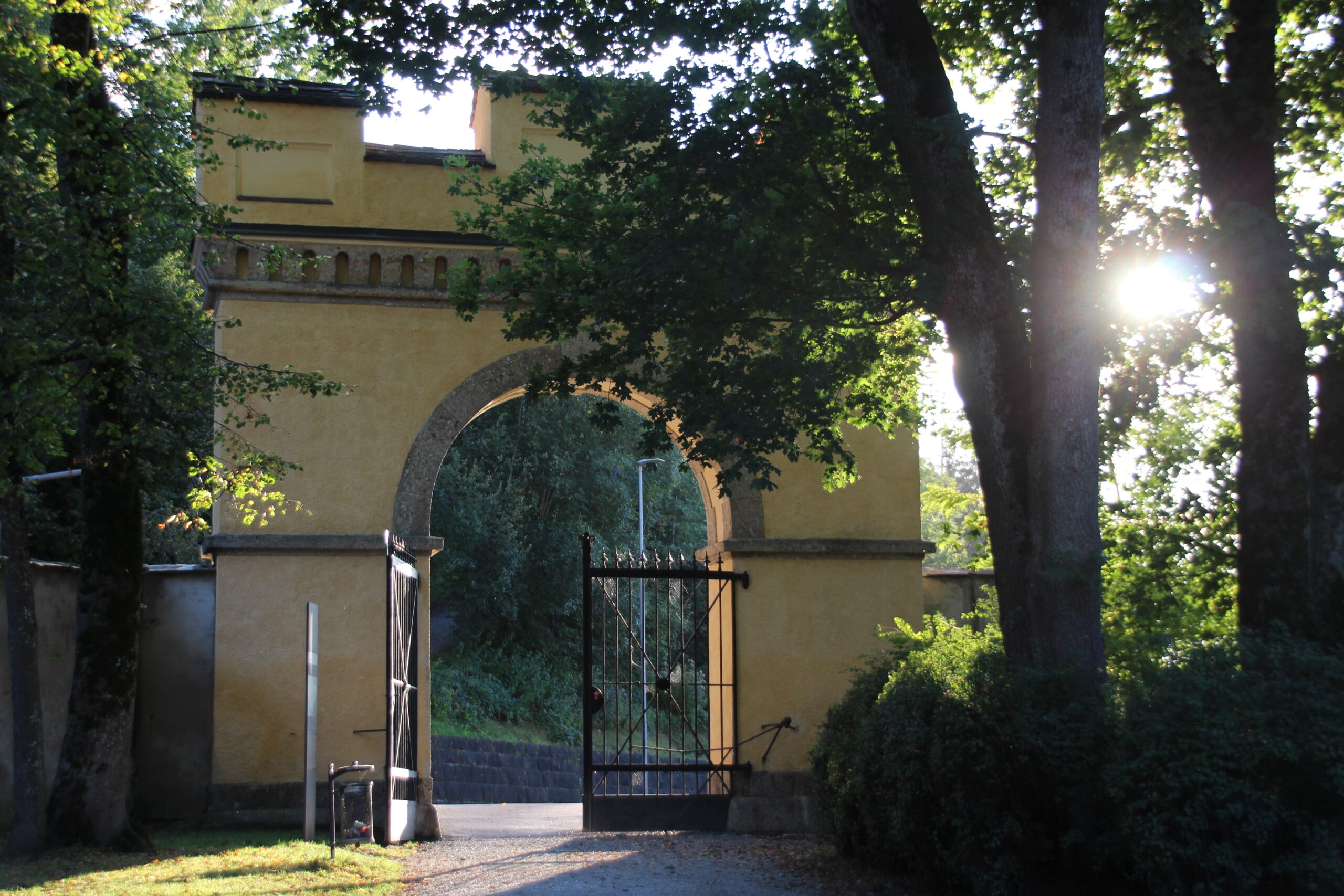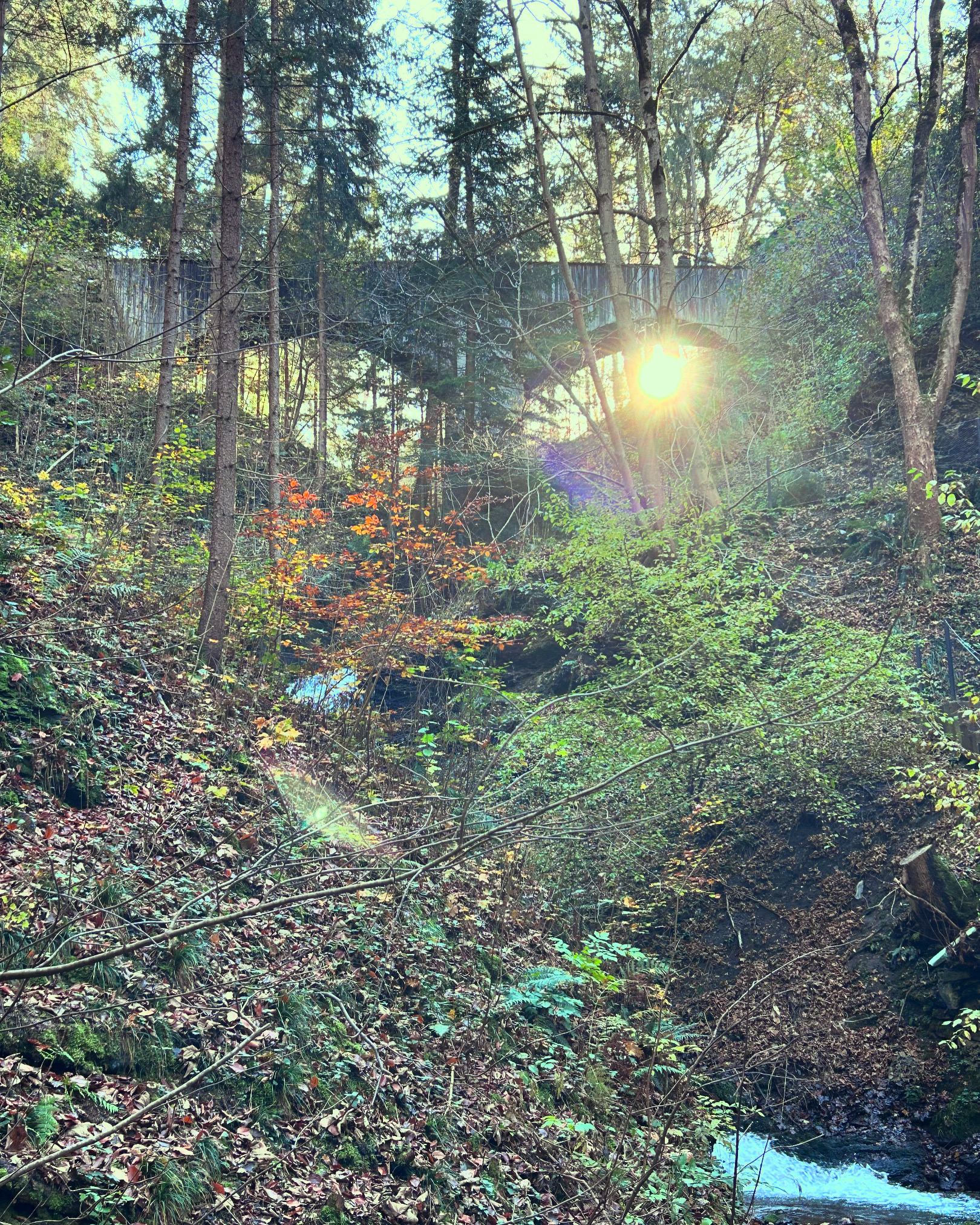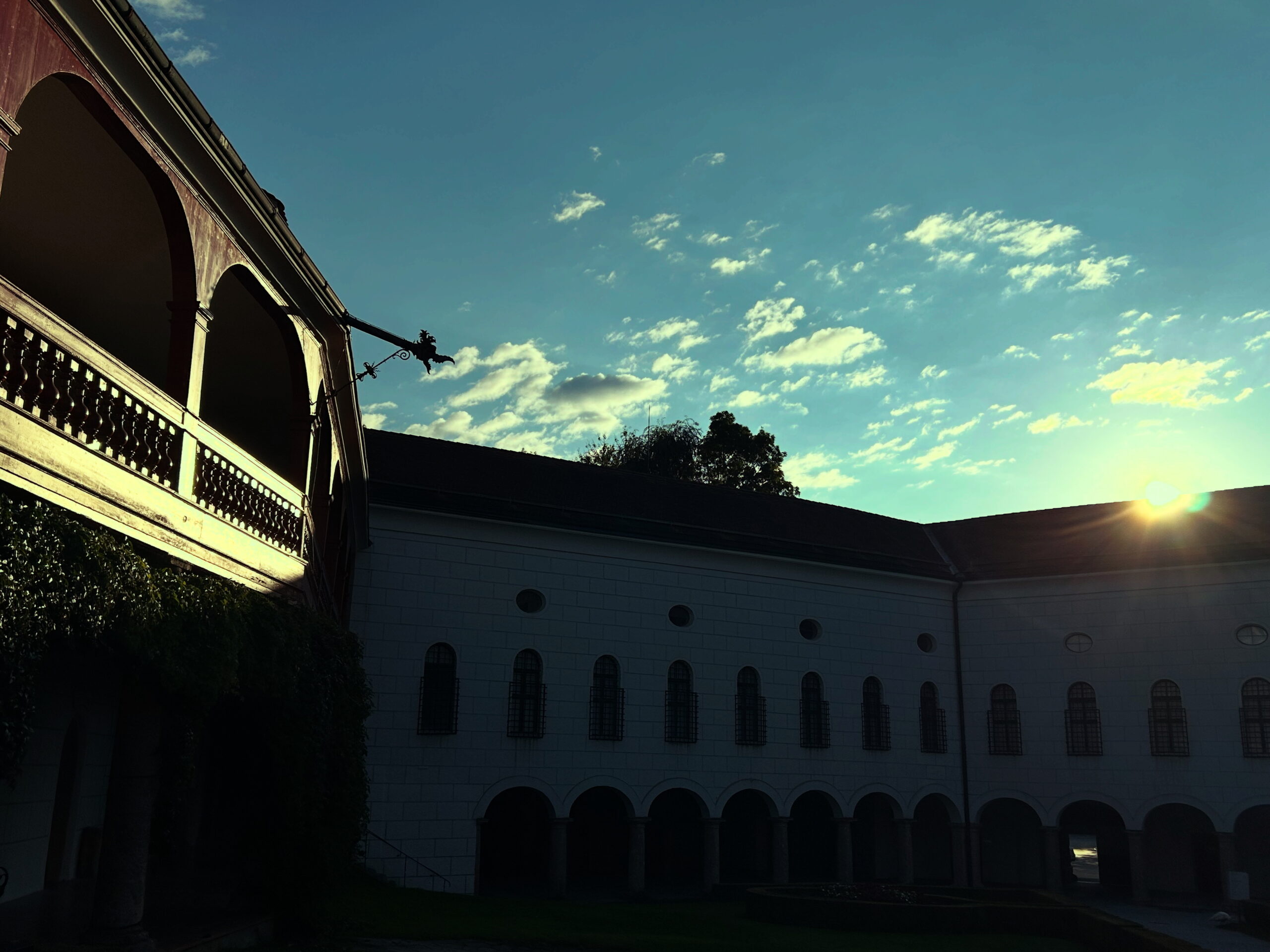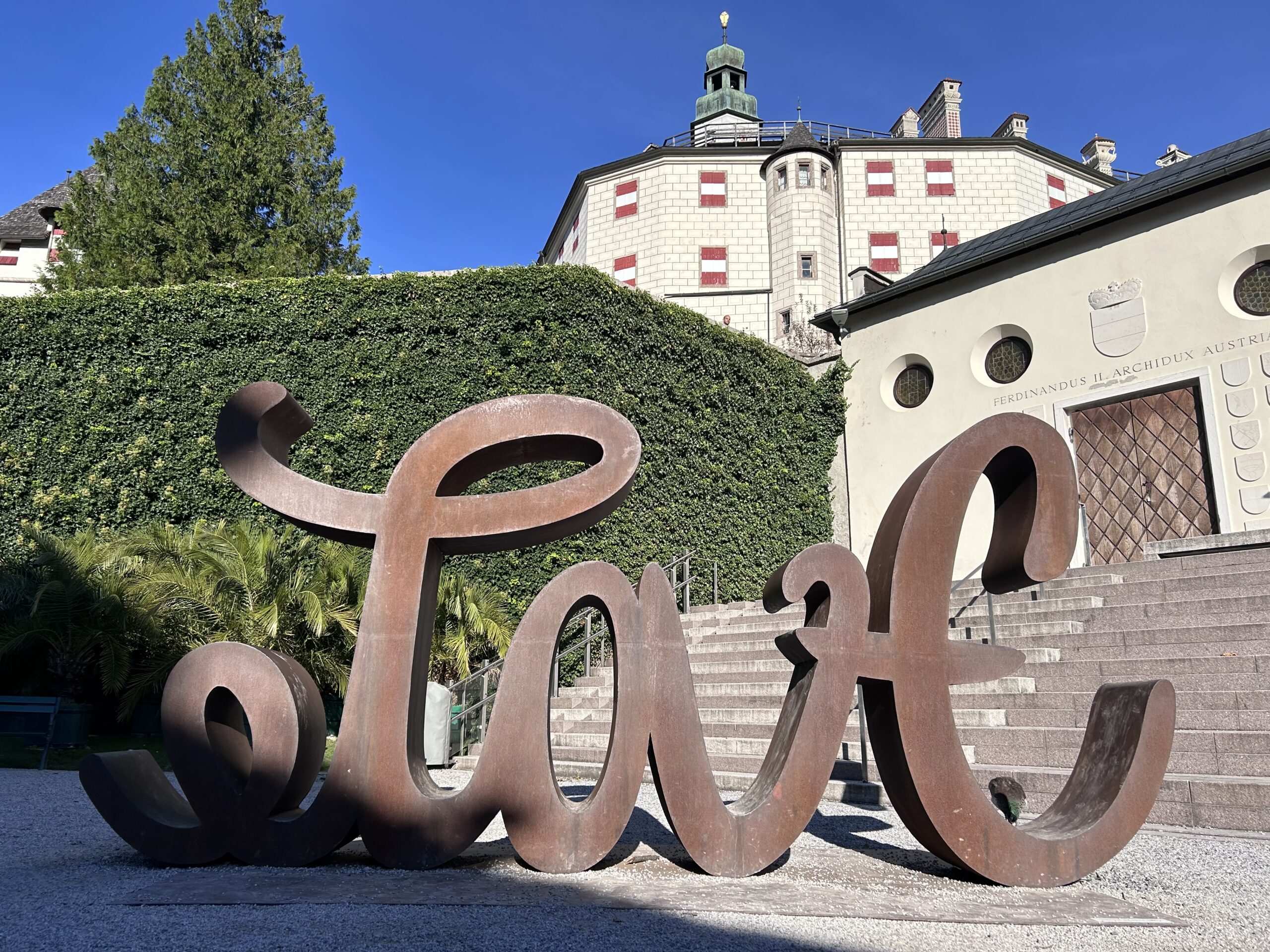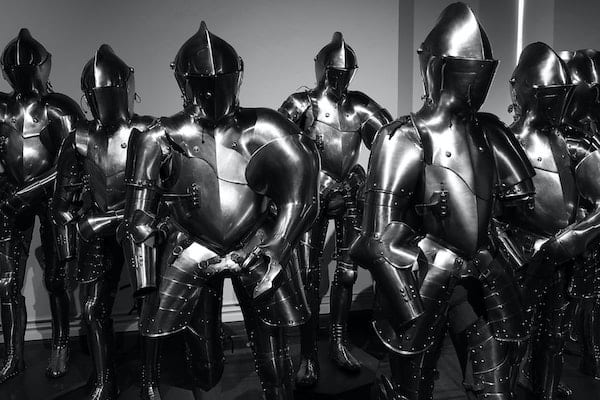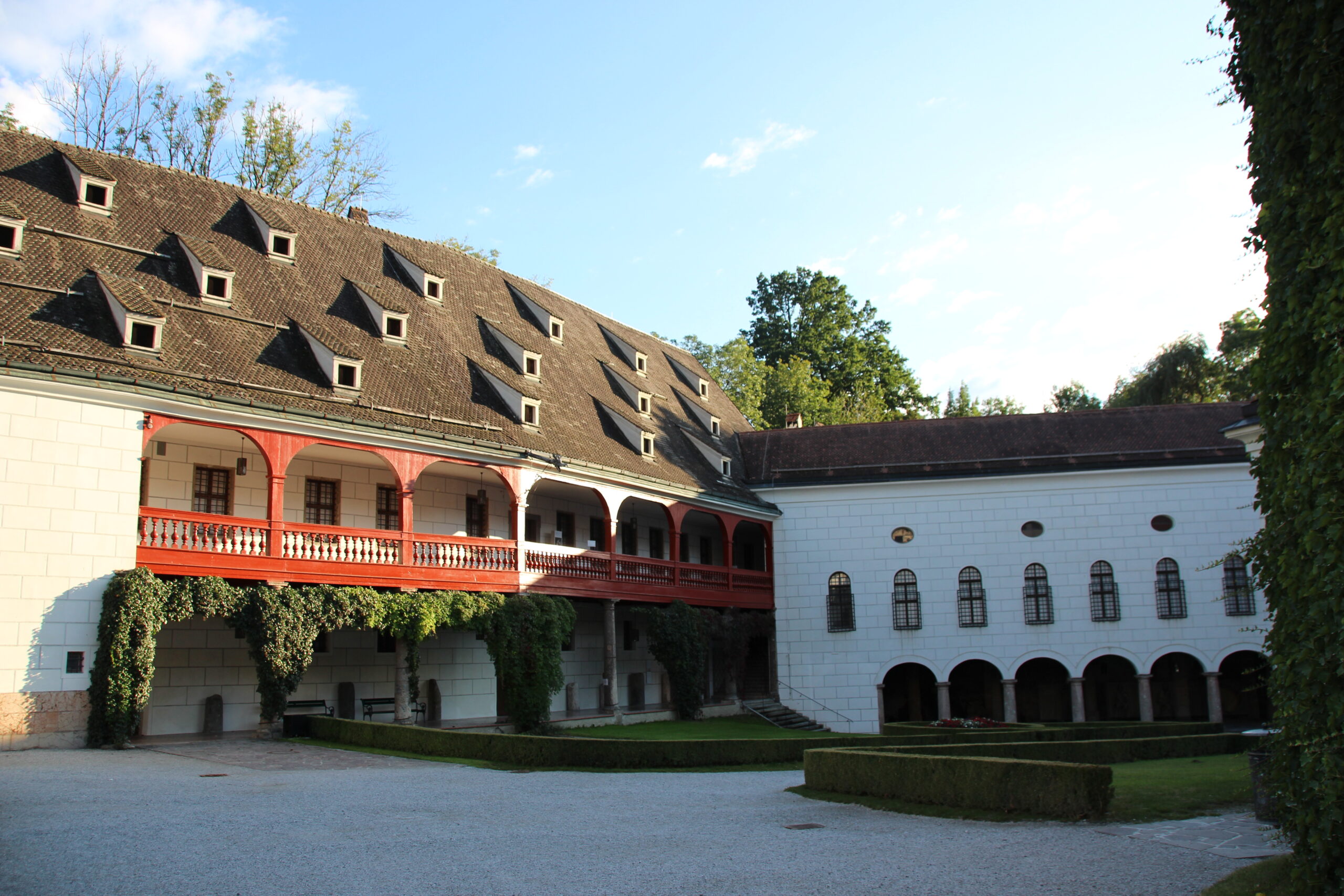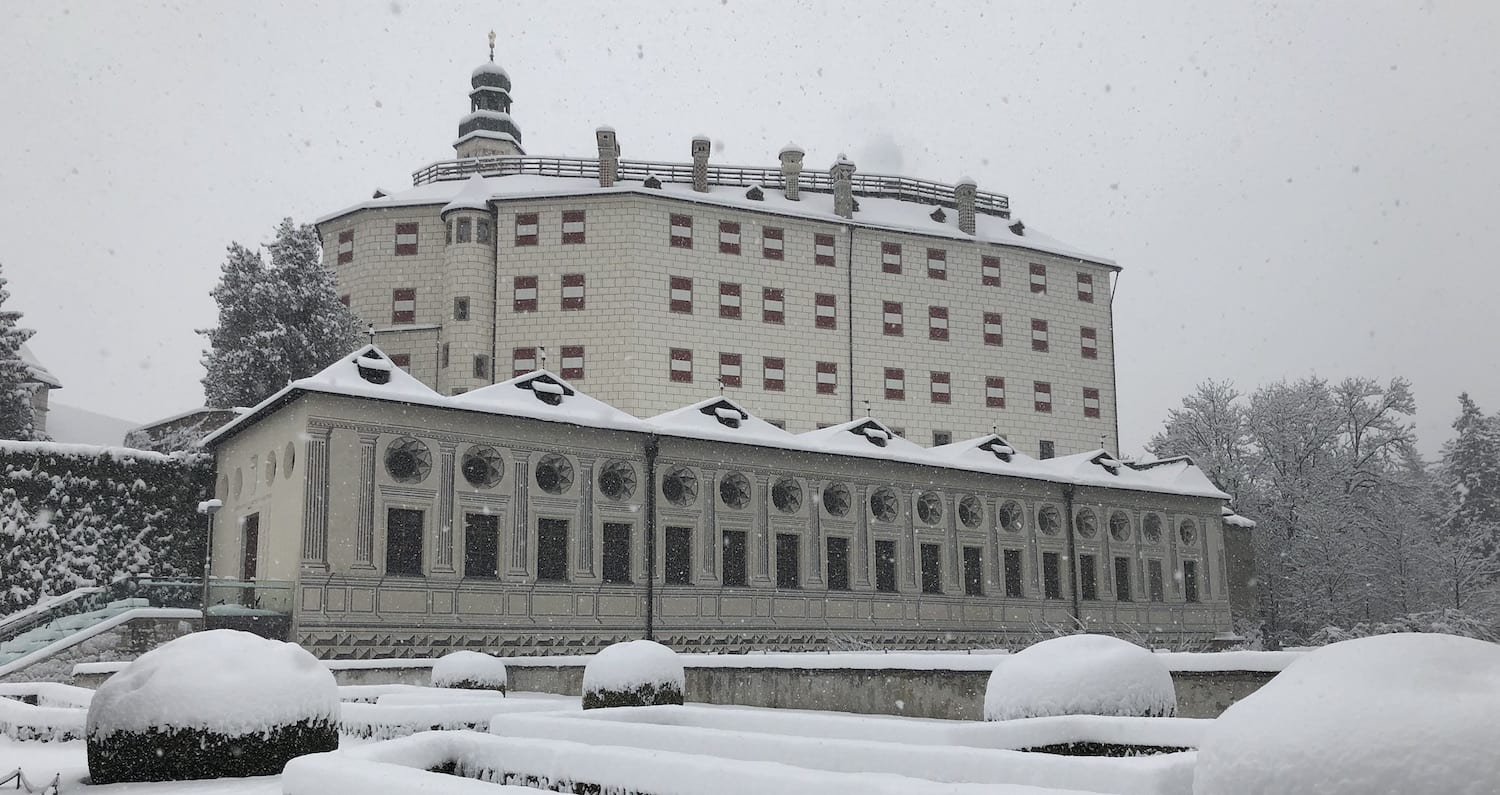Schloss Ambras
Schloßstraße 12-20
Worth knowing
Das Schloss Ambras ist das Highlight der Renaissancekultur in Innsbruck. Schon im frühen Mittelalter stand eine Befestigungsanlage am Ort des heutigen Schloss Ambras. Die Grafen von Andechs hatten eine Burg errichtet, die 1133 bei einer Fehde zwischen Otto II. von Andechs und Herzog Henry the Proud of Bavaria as part of the investiture dispute between the Hohenstaufen and Guelph dynasties. The issue at stake was whether the pope or king were allowed to appoint bishops they trusted. The question was important for the Andechs, as they were dependent on the goodwill of the respective church leaders in order to retain their offices and fiefdoms.
Auf den Ruinen der Burg entstand im 13. Jahrhundert erneut eine Burg, die wenig mit dem heutigen Schloss gemeinsam hatte. Der Tiroler Landesfürst Siegmund ließ die Anlage für seine Frau Katharina von Sachsen etwas komfortabler umbauen. Die Transformation von der Wehranlage zum Wohnschloss begann. Sein Nachfolger Maximilian verpfändete die Burg an Wilhelm Schurff (1484 – 1556), den Bruder seines Truchsesses.
Under Maximilian's great-grandson Ferdinand II. Omeras was remodelled by court architect Lucchese into Ambras Castle in its present appearance. Innsbruck was to be in no way inferior to the princely courts of northern Italy that served as models in the Renaissance period. From 1564 onwards, Ferdinand had the high castle, the Spanischen Saal and a palace garden. Together with his wife Philippine Welser, Ferdinand used the new complex as a residential palace. Lavish parties were celebrated here. Aristocratic guests, often travelling through from the German lands to Italy, enjoyed his hospitality at Ambras Castle to the full. At great expense to himself and his guests, he organised lavish parties at Ambras Castle. Mottoparties with costumes and feasts in the spirit of the Renaissance. At the Bacchanalien the members had to empty huge cups of wine in one go to imitate the participants in the ancient symposia. The Bacchusgrotte opposite the high castle is a reminder of this. The garden, including the imposing waterfall, was also laid out as the court's own hunting ground under Ferdinand. The prince and his guests were able to go hunting in Ambras Castle right outside the front door. Lustjagd which was usually crowned with success thanks to the uneven distribution of chances in the rather manageable garden.
The nobility had the privilege of hunting at the discretion of the sovereign. After the change in the law under Maximilian I around 1500, hunting had become a kind of sport. Hunting deer and chamois was mostly reserved for the high aristocracy. The lesser nobility were allowed to hunt rabbits, roe deer and other smaller animals. The terms "big game" and "small game" originate from this custom.
Ferdinand housed his extensive art collection in the Lower Castle. The portraits, paintings, weapons, armour, musical instruments and scientific research objects were considered to be one of the largest collections in Europe in the 16th century. In the spirit of the late Renaissance, Ferdinand wanted to do justice to the universal claim to knowledge. His collection also bears witness to the influence that Jesuit scholars had at court and in education. Wunderkammer Ferdinand's collection provides an insight into his passion for research and collecting. Together with the art collection of the French King Francis I, from which the Louvre was to emerge, the papal collections and the collections publicly displayed in Florence on the Piazza della Signoria With its many works of art on display, some of which can be admired today in the Uffizi Gallery, Ferdinand's art collection was one of the first exhibitions that could be described as a museum. Ambras Castle was probably unique in terms of the scope and diversity of its artefacts.
The castle park in its current form of an English landscape garden was laid out in the 19th century. A stroll through the extensive grounds, laid out at different levels with bridges, waterfalls, a pond and peacocks, is very beautiful all year round.
In 1859, the castle underwent another renovation, during which parts were unfortunately treated rather carelessly. Walls, rooms and frescoes were lost forever.
Ambras Castle has been open to the public as a museum since 1880. Today it is managed by the Kunsthistorisches Museum Vienna. The garden and museum are examples of the opening up of estates formerly reserved for the nobility. The violent revolution may not have taken place in Tyrol in 1848, but the bourgeois revolution took place in leisure behaviour. Places such as the Hofgarten and Ambras Castle, and later Mount Isel, were among the favourite destinations of Innsbruck residents for excursions and walks.
The last major remodelling work was carried out in 1922 and 1976.
The highlights of a visit to Ambras Castle are the armoury and the still extensive collection of paintings, the inner courtyard, the magnificent Spanische Saal, Philippine Welser's bathroom and the richly decorated St Nicholas Chapel from the 19th century. One of the many different themed tours of the palace with an expert guide or audio guide is highly recommended.
Ferdinand II.: Renaissance, Glanz und Glamour
Archduke Ferdinand II of Austria (1529 - 1595) is one of the most colourful figures in Tyrolean history. His father, Emperor Ferdinand I, gave his son an excellent education. He grew up at the Spanish court of his uncle Emperor Charles V. He spent part of his youth at the court in Innsbruck, which was also influenced by Spain at the time. The years in which Ferdinand received his schooling were the early years of Jesuit influence at the Habsburg courts. At a young age, he travelled through Italy and Burgundy and had become acquainted with a lifestyle at the wealthy courts there that had not yet established itself among the German aristocracy. Ferdinand was what today would be described as a globetrotter, a member of the educated elite or a cosmopolitan. He was considered intelligent, charming and artistic. Among his less eccentric contemporaries, Ferdinand enjoyed a reputation as an immoral and hedonistic libertine. Even during his lifetime, he was rumoured to have organised debauched and immoral orgies.
Ferdinand had taken over the province of Tyrol as sovereign in turbulent times. The mines in Schwaz began to become unprofitable due to the cheap silver from America. The flood of silver from the New World led to inflation. This did not stop him from maintaining an expensive court, while the cost of living rose for the poorer sections of the population. The Italian cities were style-defining in terms of culture, art and architecture. Ferdinand's Tyrolean court was in no way inferior to these cities. His masked balls and parades were legendary. Ferdinand had Innsbruck remodelled in the spirit of the Renaissance. In keeping with the trend of the time, he imitated the Italian aristocratic courts in Florence, Mantua, Ferrara and Milan. Court architect Giovanni Lucchese assisted him in this endeavour. Gone were the days when Germans in the more beautiful cities south of the Alps were regarded as uncivilised, barbaric or even as Pigs were labelled.
But Ambras Castle was not the end of the story. To the west of the town, an archway is a reminder of the Tiergarten, ein Jagdrevier Ferdinands samt Lusthaus entworfen ebenfalls von Lucchese. Damit der Landesfürst sein Wochenenddomizil erreichen konnte, wurde eine Straße in die sumpfige Höttinger Au gelegt, die die Basis für die heutige Kranebitter Allee bildete. Das Lusthaus wurde 1786 durch den heute als Pulverturm The new building, which houses part of the sports science faculty of the University of Innsbruck, replaced the well-known building. The princely sport of hunting was followed in the former Lusthaus, das der Pulverturm war, die Sportuniversität nach. In der Innenstadt ließ er das fürstliche Comedihaus am heutigen Rennweg errichten. Um Innsbrucks Trinkwasserversorgung zu verbessern, wurde unter Ferdinand die Mühlauerbrücke errichtet, um eine Wasserleitung vom Mühlaubach ins Stadtgebiet zu verlegen.
Ferdinand's politics were also influenced by Italy. Machiavelli wrote his work "Il Principe", which stated that rulers were allowed to do whatever was necessary for their success if they were incompetent and could be deposed. Ferdinand II attempted to do justice to this early absolutist style of leadership and issued a modern set of legal rules for the time with his Tyrolean Provincial Code. The Jesuits, who had arrived in Innsbruck shortly before Ferdinand took office to make life difficult for troublesome reformers and church critics, reorganise the education system and strengthen the church's presence, were given a new church in Silbergasse. It may seem contradictory today that the pleasure-seeking Prince Ferdinand defended the church as a Catholic and counter-reformer, but this was not the case in the late Renaissance period. With his measures against the Jewish population, he was also in line with the Jesuits.
Ferdinand spent a considerable part of his life at Ambras Castle near Innsbruck, where he amassed one of the most valuable collections of works of art and armour in the world.
Ferdinand's first "semi-wild marriage" was to the commoner Philippine Welser. The sovereign is said to have been downright infatuated with his beautiful wife, which is why he disregarded all conventions of the time. Their children were excluded from the succession due to the strict social order of the 16th century. After Philippine Welser died, Ferdinand married the devout Anna Caterina Gonzaga, a 16-year-old princess of Mantua, at the age of 53. However, it seems that the two did not feel much affection for each other, especially as Anna Caterina was a niece of Ferdinand. The Habsburgs were less squeamish about marriages between relatives than they were about the marriage of a nobleman to a commoner. However, he was also "only" able to father three daughters with her. Ferdinand found his final resting place in the Silver Chapel with his first wife.
Philippine Welser: Klein Venedig, Kochbücher und Kräuterkunde
Philippine Welser was the wife of Archduke Ferdinand II. The Welsers were one of the wealthiest non-aristocratic families of their time. Her uncle Bartholomäus Welser was similarly wealthy to Jakob Fugger. He had also granted loans to the Habsburgs. Instead of paying off the loans, Emperor Charles V pledged part of the newly annexed lands in America to the Welsers, who in return used the land as a colony. Klein-VenedigVenezuela, with fortresses and settlements. They organised expeditions to discover the legendary land of gold El Dorado to discover. In order to get as much as possible out of their fiefdom, they set up trading posts to take part in the profitable transatlantic slave trade between Europe, West Africa and America. Their brutal behaviour led to complaints at the imperial court, where they were subsequently stripped of their fiefdom.
Ferdinand and Philippine met at a carnival ball in Pilsen. The Habsburg fell head over heels in love with the wealthy woman from Augsburg and married her. Nobody in the House of Habsburg was particularly pleased about the couple's secret marriage, even though the Welser's money was put to good use. Despite their wealth, marriages between commoners and nobles were considered scandalous and not befitting their status. The children were therefore excluded from the succession.
Philippine galt als überaus schön. Ihre Haut sei laut Zeitzeugen so zart gewesen, „man hätte einen Schluck Rotwein durch ihre Kehle fließen sehen können". Ferdinand had Ambras Castle remodelled into its present form for his beloved wife. His brother Maximilian even said that "Ferdinand verzaubert sai" by the beautiful Philippine Welser, when Ferdinand withdrew his troops during the Turkish war to go home to his wife.
Philippine Welser's passion was cooking. A collection of recipes still exists in the Austrian National Library today. In the Middle Ages and early modern times, the art of cookery was practised exclusively by the wealthy and nobility, while the vast majority of subjects had to eat whatever was available. The Middle Ages and modern times, in fact all people up until the 1950s, lived with a permanent lack of calories. Whereas today we eat too much and get ill as a result, our ancestors suffered from illnesses caused by malnutrition. Fruit was just as rare on the menu as meat. The food was monotonous and hardly flavoured. Spices such as exotic pepper were luxury goods that ordinary people could not afford. While the diet of the ordinary citizen was a dull affair, where the main aim was to get the calories for the daily work as efficiently as possible, the attitude towards food and drink began to change in Innsbruck under Ferdinand II and Philippine Welser. The court had contributed to a certain cultivation of manners and customs since Frederick IV, and Philippine Welser and Ferdinand continued to drive this development at Ambras Castle and Weiherburg Castle. The banquets they organised were legendary and often degenerated into orgies.
Herbalism was her second hobbyhorse. Philippine Welser described how plants and herbs could be used to alleviate physical ailments of all kinds. At Ambras Castle in Innsbruck, she had a herb garden created for her hobby and her studies.
According to reports of the time, she was very popular among the Tyrolean population, as she took great care of the poor and needy. The care of the needy, led by the town council and sponsored by wealthy citizens and aristocrats, was not a speciality at the time, but common practice. Closer to salvation in the next life than through Christian charity, Caritasyou could not come.
, konnte man nicht kommen. Ihre letzte Ruhe fand Philippine Welser nach ihrem Tod 1580 in der Silbernen Kapelle in der Innsbrucker Hofkirche. Gemeinsam mit ihren als Säugling verstorbenen Kindern und Ferdinand wurde sie dort begraben. Unterhalb des Schloss Ambras erinnert die Philippine-Welser-Straße an sie.
Innsbruck and the House of Habsburg
Today, Innsbruck's city centre is characterised by buildings and monuments that commemorate the Habsburg family. For many centuries, the Habsburgs were a European ruling dynasty whose sphere of influence included a wide variety of territories. At the zenith of their power, they were the rulers of a "Reich, in dem die Sonne nie untergeht". Through wars and skilful marriage and power politics, they sat at the levers of power between South America and the Ukraine in various eras. Innsbruck was repeatedly the centre of power for this dynasty. The relationship was particularly intense between the 15th and 17th centuries. Due to its strategically favourable location between the Italian cities and German centres such as Augsburg and Regensburg, Innsbruck was given a special place in the empire at the latest after its elevation to the status of a royal seat under Emperor Maximilian. Some of the Habsburg rulers had no special relationship with Tyrol, nor did they have any particular affection for this German land. Ferdinand I (1503 - 1564) was educated at the Spanish court. Maximilian's grandson Charles V had grown up in Burgundy. When he set foot on Spanish soil for the first time at the age of 17 to take over his mother Joan's inheritance of the kingdoms of Castile and Aragon, he did not speak a word of Spanish. When he was elected German Emperor in 1519, he did not speak a word of German.
Tyrol was a province and, as a conservative region, usually favoured by the ruling family. Its inaccessible location made it the perfect refuge in troubled and crisis-ridden times. Charles V (1500 - 1558) fled during a conflict with the Protestant Schmalkaldischen Bund to Innsbruck for some time. Ferdinand I (1793 - 1875) allowed his family to stay in Innsbruck, far away from the Ottoman threat in eastern Austria. Shortly before his coronation in the turbulent summer of the 1848 revolution, Franz Josef I enjoyed the seclusion of Innsbruck together with his brother Maximilian, who was later shot by insurgent nationalists as Emperor of Mexico. A plaque at the Alpengasthof Heiligwasser above Igls reminds us that the monarch spent the night here as part of his ascent of the Patscherkofel.
Not all Habsburgs were always happy to be in Innsbruck. Married princes and princesses such as Maximilian's second wife Bianca Maria Sforza or Ferdinand II's second wife Anna Caterina Gonzaga were stranded in the harsh, German-speaking mountains after their wedding without being asked. If you also imagine what a move and marriage from Italy to Tyrol to a foreign man meant for a teenager, you can imagine how difficult life was for the princesses. Until the 20th century, children of the aristocracy were primarily brought up to be politically married. There was no opposition to this. One might imagine courtly life to be ostentatious, but privacy was not provided for in all this luxury.
When Sigismund Franz von Habsburg (1630 - 1665) died childless as the last prince of the province, the title of royal seat was also history and Tyrol was ruled by a governor. Tyrolean mining had lost its importance. Shortly afterwards, the Habsburgs lost their possessions in Western Europe along with Spain and Burgundy, moving Innsbruck from the centre to the periphery of the empire. In the Austro-Hungarian monarchy of the 19th century, Innsbruck was the western outpost of a huge empire that stretched as far as today's Ukraine. Franz Josef I (1830 - 1916) ruled over a multi-ethnic empire between 1848 and 1916. However, his neo-absolutist concept of rule was out of date. Although Austria had had a parliament and a constitution since 1867, the emperor regarded this government as "his". Ministers were responsible to the emperor, who was above the government. The ailing empire collapsed in the second half of the 19th century. On 28 October 1918, the Republic of Czechoslovakia was proclaimed, and on 29 October, Croats, Slovenes and Serbs left the monarchy. The last Emperor Charles abdicated on 11 November. On 12 November, "Deutschösterreich zur demokratischen Republik, in der alle Gewalt vom Volke ausgeht“. The chapter of the Habsburgs was over.
Despite all the national, economic and democratic problems that existed in the multi-ethnic states that were subject to the Habsburgs in various compositions and forms, the subsequent nation states were sometimes much less successful in reconciling the interests of minorities and cultural differences within their territories. Since the eastward enlargement of the EU, the Habsburg monarchy has been seen by some well-meaning historians as a pre-modern predecessor of the European Union. Together with the Catholic Church, the Habsburgs shaped the public sphere through architecture, art and culture. Goldenes DachlThe Hofburg, the Triumphal Gate, Ambras Castle, the Leopold Fountain and many other buildings still remind us of the presence of the most important ruling dynasty in European history in Innsbruck.
The Counts of Andechs and the foundation of Innsbruck
The 12th century brought economic, scientific and social prosperity and is regarded as a kind of early medieval renaissance. Via the Crusades, there was an increased exchange with the cultures of the Middle East, which were more developed in many respects. Arab scholars brought translations of Greek thinkers such as Aristotle to Europe via southern Spain and Italy. Roman law was rediscovered at the first universities south of the Alps. New agricultural knowledge and a favourable climate, which was to last until the middle of the 14th century, made it possible for towns and larger settlements to emerge. One of these settlements was located north of the Wilten monastery between the Inn and the Nordkette mountain range.
After the disappearance of the Western Roman Empire and its administration, various Germanic tribes such as the Ostrogoths and Franks took control of the area that is now Innsbruck. They left ecclesiastical institutions and structures in place to administer the area, as clerics were often the only scribes. A small upper class of armoured aristocrats ruled in a strict hierarchy over the majority of the population, who worked in agriculture in 90%.
In the 6th century, there was increasing Bavarian settlement in the Inn Valley. During the reign of Charlemagne (ca. 748 - 814), the dukes of Bavaria became feudatories of the German kings, whose empire extended over large parts of central Europe and northern Italy. The Breton-Romanised population was displaced after minor conflicts. However, parts of the Christianised culture of the Heiligen Römischen Reichs. Politically, the importance of the North Tyrolean region was mainly limited to the transit sector.
Tyrol had two low Alpine crossings, the Reschen Pass and the Brenner Pass, which were important for the imperial connection between the German lands in the north and the lands in Italy. In 1024, the Salian Conrad II, a rival of the Bavarian dukes from the House of Wittelsbach, was elected king. In order to bring these two Alpine crossings away from his Bavarian rivals and under the control of the imperial church, which was loyal to him, Conrad II granted the territory of Tyrol as a fief to the bishops of Brixen and Trento in 1027. The bishops in turn needed so-called bailiffs to administer these lands and administer justice.
These bailiffs of the Bishop of Brixen were the Counts of Andechs. The Andechs family may be overshadowed today by the Guelphs, Hohenstaufen, Wittelsbach and Habsburg dynasties, but they were an influential family in the High Middle Ages. They came from the area around Lake Ammer in Bavaria and owned estates in Upper Bavaria between the Lech and Isar rivers and east of Munich. Through skilful marriage politics, they had acquired the titles of Dukes of Merania, a region on the Dalmatian coast, and Margraves of Istria. They thus rose in rank within the Heiligen Römischen Reiches on. In the 12th century, they founded the Dießen monastery and the monastery on the holy mountain of Andechs above Lake Ammersee to ensure both administration and later salvation. In 1165, Otto V of Andechs came to the bishop's see in Brixen and gave the bailiwick over this high monastery to his brother. From then on, they administered the central part of the Inn Valley, the Wipp Valley, the Puster Valley and the Eisack Valley.
Today, Innsbruck stretches along both sides of the Inn. In the 12th century, this area was under the influence of two lords of the manor. South of the Inn, Wilten Abbey exercised lordship. The area north of the river was under the administration of the Andechs. While the southern part of the town around the monastery was used for agriculture from an early stage, the alluvial area of the unregulated watercourse could not be cultivated before the High Middle Ages and was sparsely populated.
The Inn Valley was densely wooded and wild. Most of the people at that time worked in agriculture, which was run by their landlord. They lived in poor huts made of mud and wood. There was hardly any medical care outside the towns, infant mortality was high and hardly anyone lived past the age of 50. Around the year 1133, the Andechs founded the market here Anbruggen and connected the northern and southern banks of the Inn via a bridge. The construction of the bridge turned the unusable agricultural land at the foot of the Nordkette mountain range into a trading centre. It greatly facilitated the movement of goods in the Eastern Alps. The Brenner route had become more interesting thanks to one of the innovations of the medieval Renaissance: new harnesses made it possible to negotiate the steep climbs with carts. The shorter Via Raetia had the Via Claudia Augusta over the Reschen Pass as the main transport route across the Alps. The customs revenue generated from trade between the German and Italian towns allowed the settlement to prosper. Blacksmiths, innkeepers and craftsmen settled in the small market.
Anbruggen grew rapidly, but the space between the Nordkette and the Inn was limited. In 1180, Berchtold V of Andechs acquired a piece of land on the south side of the Inn from Wilten Monastery. This was the starting signal for Innsbruck. In the course of building the city wall, the Counts of Andechs had the Andechs Castle and moved their headquarters from Merano to Innsbruck. The new settlement also grew rapidly thanks to the customs revenue.
Sometime between 1187 and 1204, the people of Innsbruck were granted city rights. The official date of foundation is often taken as 1239, when the last count of the Andechs dynasty, Otto VIII, formally confirmed the town charter in a document.
Innsbruck was already the mint of the Andechs at this time and would probably have become the capital of their principality. But things turned out differently. In 1246, the Bavarian Wittelsbach dynasty, the Andechs' biggest rivals in southern Germany, destroyed their ancestral castle on Lake Ammersee. Otto, the last count of the House of Andechs-Merania, died without descendants in 1248. 12 years earlier, he had married Elisabeth, the daughter of Count Albert VIII of Tyrol. This noble family with its ancestral castle in Meran thus took over the fiefs and parts of the possessions, including the town on the Inn, as well as the arch-enemy with the Bavarian Wittelsbachs.
March 1848... and what it brought
The year 1848 occupies a mythical place in European history. Although the hotspots were not to be found in secluded Tyrol, but in the major metropolises such as Paris, Vienna, Budapest, Milan and Berlin, even in the Holy Land however, the revolutionary year left its mark. In contrast to the rural surroundings, an enlightened educated middle class had developed in Innsbruck. Enlightened people no longer wanted to be subjects of a monarch or sovereign, but citizens with rights and duties towards the state. Students and freelancers demanded political participation, freedom of the press and civil rights. Workers demanded better wages and working conditions. The omnipotence of the church was called into question.
In March 1848, this socially and politically highly explosive mixture erupted in riots in many European cities. In Innsbruck, students and professors celebrated the newly enacted freedom of the press with a torchlight procession. On the whole, however, the revolution proceeded calmly in the leisurely Tyrol. It would be foolhardy to speak of a spontaneous outburst of emotion; the date of the procession was postponed from 20 to 21 March due to bad weather. There were hardly any anti-Habsburg riots or attacks; a stray stone thrown into a Jesuit window was one of the highlights of the Alpine version of the 1848 revolution. The students even helped the city magistrate to monitor public order in order to show their gratitude to the monarch for the newly granted freedoms and their loyalty.
The initial enthusiasm for bourgeois achievements was quickly replaced by German nationalist, patriotic fervour in Innsbruck. On 6 April 1848, the German flag was waved by the governor of Tyrol during a ceremonial procession. A German flag was also raised on the city tower. Tricolour gehisst. Während sich Studenten und Konservative bei gesellschaftlichen Themen wie der Pressefreiheit nicht einig wurden, teilte man die Abneigung gegen die italienische Unabhängigkeitsbewegung. Innsbrucker Studenten und Schützen zogen mit Unterstützung der k.k. Armeeführung ins Trentino, um die Unruhen und Aufstände im Keim zu ersticken. Bekannte Mitglieder dieses Korps waren der bereits in die Jahre gekommene Pater Haspinger, der bereits mit Andreas Hofer 1809 zu Felde zog, und Adolf Pichler.
Auch die Stadt Innsbruck als politisches und wirtschaftliches Zentrum des multinationalen Kronlandes Tirol und Heimat vieler Italienischsprachiger wurde zur Arena dieses Nationalitätenkonflikts. In Kombination mit reichlich Alkohol bereiteten anti-italienische Gefühle in Innsbruck mehr Gefahr für die öffentliche Ordnung als die nach bürgerlichen Freiheiten. Ein Streit zwischen einem deutschsprachigen Handwerker und einem italienischsprachigen Ladiner schaukelte sich dermaßen auf, dass es beinahe zu einem Pogrom gegenüber den zahlreichen Betrieben und Gaststätten von italienischsprachigen Tirolern gekommen wäre.
Die relative Beschaulichkeit Innsbrucks kam dem unter Druck stehenden Kaiserhaus recht. Als es in Wien auch nach dem März nicht aufhörte zu brodeln, floh Kaiser Ferdinand im Mai nach Tirol. Innsbruck war wieder Residenz des Kaisers, wenn auch nur für einen Sommer. Folgt man den Presseberichten aus dieser Zeit, wurde er hier von der Bevölkerung begeistert empfangen.
"Wie heißt das Land, dem solche Ehre zu Theil wird, wer ist das Volk, das ein solches Vertrauen genießt in dieser verhängnißvollen Zeit? Stützt sich die Ruhe und Sicherheit hier bloß auf die Sage aus alter Zeit, oder liegt auch in der Gegenwart ein Grund, auf dem man bauen kann, den der Wind nicht weg bläst, und der Sturm nicht erschüttert? Dieses Alipenland heißt Tirol, gefällts dir wohl? Ja, das tirolische Volk allein bewährt in der Mitte des aufgewühlten Europa die Ehrfurcht und Treue, den Muth und die Kraft für sein angestammtes Regentenhaus, während ringsum Auflehnung, Widerspruch. Trotz und Forderung, häufig sogar Aufruhr und Umsturz toben; Tirol allein hält fest ohne Wanken an Sitte und Gehorsam, auf Religion, Wahrheit und Recht, während anderwärts die Frechheit und Lüge, der Wahnsinn und die Leidenschaften herrschen anstatt folgen wollen. Und während im großen Kaiserreiche sich die Bande überall lockern, oder gar zu lösen drohen; wo die Willkühr, von den Begierden getrieben, Gesetze umstürzt, offenen Aufruhr predigt, täglich mit neuen Forderungen losgeht; eigenmächtig ephemere- wie das Wetter wechselnde Einrichtungen schafft; während Wien, die alte sonst so friedliche Kaiserstadt, sich von der erhitzten Phantasie der Jugend lenken und gängeln läßt, und die Räthe des Reichs auf eine schmähliche Weise behandelt, nach Laune beliebig, und mit jakobinischer Anmaßung, über alle Provinzen verfügend, absetzt und anstellt, ja sogar ohne Ehrfurcht, den Kaiaer mit Sturm-Petitionen verfolgt; während jetzt von allen Seiten her Deputationen mit Ergebenheits-Addressen mit Bittgesuchen und Loyalitätsversicherungen dem Kaiser nach Innsbruck folgen, steht Tirol ganz ruhig, gleich einer stillen Insel, mitten im brausenden Meeressturme, und des kleinen Völkchens treue Brust bildet, wie seine Berge und Felsen, eine feste Mauer in Gesetz und Ordnung, für den Kaiser und das Vaterland."
In 1848, Ferdinand left the throne to the young Franz Josef I. In July 1848, the first parliamentary session was held in the Court Riding School in Vienna. The first constitution was enacted. However, the monarchy's desire for reform quickly waned. The new parliament was an imperial council, it could not pass any binding laws, the emperor never attended it during his lifetime and did not understand why the Danube Monarchy, as a divinely appointed monarchy, needed this council.
Nevertheless, the liberalisation that had been gently set in motion took its course in the cities. Innsbruck was given the status of a town with its own statute. Innsbruck's municipal law provided for a right of citizenship that was linked to ownership or the payment of taxes, but legally guaranteed certain rights to members of the community. Birthright citizenship could be acquired by birth, marriage or extraordinary conferment and at least gave male adults the right to vote at municipal level. If you got into financial difficulties, you had the right to basic support from the town.
On 2 June 1848, the first issue of the liberal and pro-German Innsbrucker Zeitung was published, from which the above article on the arrival of the Emperor in Innsbruck is taken. The previously abolished censorship was partially reintroduced. Newspaper publishers had to undergo some harassment by the authorities. Newspapers were not allowed to write against the provincial government, the monarchy or the church.
"Anyone who, by means of printed matter, incites, instigates or attempts to incite others to take action which would bring about the violent separation of a part from the unified state... of the Austrian Empire... or the general Austrian Imperial Diet or the provincial assemblies of the individual crown lands.... Imperial Diet or the Diet of the individual Crown Lands... violently disrupts... shall be punished with severe imprisonment of two to ten years."
After Innsbruck replaced Meran as the provincial capital in 1849 and thus finally became the political centre of Tyrol, political parties were formed. From 1868, the liberal and Greater German orientated party provided the mayor of the city of Innsbruck. The influence of the church declined in Innsbruck in contrast to the surrounding communities. Individualism, capitalism, nationalism and consumerism stepped into the breach. New worlds of work, department stores, theatres, cafés and dance halls did not supplant religion in the city either, but the emphasis changed as a result of the civil liberties won in 1848.
Perhaps the most important change to the law was the Basic relief patent. In Innsbruck hielt der Klerus, vor allem das Stift Wilten, einen großen Teil des bäuerlichen Grundbesitzes. Kirche und Adel waren nicht steuerpflichtig. 1848/49 wurden in Österreich Grundherrschaft und Untertänigkeitsverhältnis aufgehoben. Abgelöst wurden damit Grundzinsen, Zehent und Robot. Die Grundherren erhielten im Rahmen der Grundentlastung ein Drittel des Wertes ihrer Ländereien vom Staat, ein Drittel wurde als Steuererleichterung gewertet, ein Drittel der Ablöse mussten die Bauern selbst übernehmen. Die Bauern konnten diesen Betrag in Raten innert zwanzig Jahren abzahlen.
Die Nachwirkungen sind bis heute zu spüren. Die Nachkommen der damals erfolgreichen Bauern genießen durch den geerbten Landbesitz, der auf die Grundentlastung 1848 zurückzuführen ist, die Früchte des Wohlstandes und auch politischen Einfluss durch Grundstücksverkäufe für Wohnbau, Pachten und Ablösen der öffentlichen Hand für Infrastrukturprojekte. Die grundbesitzenden Adeligen von einst mussten sich mit der Schmach abfinden, bürgerlicher Arbeit nachzugehen. Der Übergang vom Geburtsrecht zum privilegierten Status innerhalb der Gesellschaft dank finanzieller Mittel, Netzwerken und Ausbildung gelang häufig. Viele Innsbrucker Akademikerdynastien nahmen ihren Ausgang in den Jahrzehnten nach 1848.

